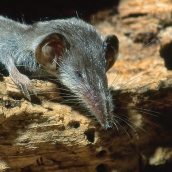Pygmy White-toothed Shrew (Suncus etruscus)
The smallest land mammal in Europe and one of the smallest in the world, this little shrew has a head and body length of just 35-53 mm. It is very similar to other shrews, but the head is proportionally larger and the tail is longer, measuring nearly half the body length. The fur is greyish-brown, and the long ears and pointed snout are characteristic of other shrews. Distribution is primarily Mediterranean but encompasses North Africa, southern Europe and central and southwest Asia. In Macaronesia it is only present in the Canaries, specifically in Tenerife, where it was introduced quite recently. In fact, it was first sighted in the north of the island in 1983-1984. Since then, it has gradually spread and today appears on the southern flank, in several localities in the south and also in Teide National Park, at over 2,000 m altitude. It favours man-made environments at low- and mid-attitude (crops, gardens, golf courses, etc.), but also penetrates pinewoods, degraded evergreen forests and, less frequently, high montane scrub; it is also found among lowland Euphorbia communities and thermophile forest strongholds. It seeks shelter under stones, in walls and compost, and among pinocha or layers of pine needles. It has an extremely high metabolic rate, which forces it into a frenzy of activity, particularly at dusk and at night, though it often appears by day. Carnivorous, it is able to consume prey of considerable size (especially insects). There are very few studies on this mammal, hence the scant information on its breeding habits in the Canaries. In other areas the female produces three litters a year, of 2-5 young each. Its enemies include the domestic cat (Felis catus) and the two nocturnal birds of prey in the Canaries, the barn owl (Tyto alba alba) and the long-eared owl (Asio otus canariensis), the barn owl making the most frequent catches. Hairball analysis has shed considerable light on the gradual expansion of this little shrew in Tenerife.













